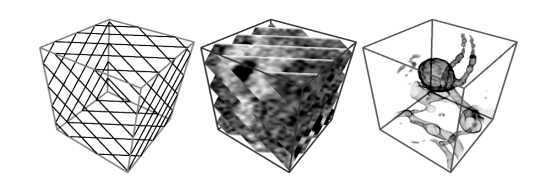3D texture
A 3D texture is mathematically described as a function that unfolds in three dimensions and that assigns a value to every point located in the defined area. It differs from a 2D texture used in texture mapping only in that the corner points are assigned three-dimensional coordinates. The slices are to be aligned parallel to the screen level and to be accumulated in a manner comparable to the back-to-front method. The texture elements furthest away from the screen plane (so-called slices ) and then all further texture elements in the direction of the framebuffer are accumulated. See also: compositing .

The sketch shows the intermediate representation of the surfaces, aligned parallel to the screen surface. After applying filters and transfer functions, a corresponding result is shown (see third figure: tissue). Source: "Combining Local and Remote Visualization Techniques for Interactive Volume Rendering in Medical Applications" by K.Engel et al.
By using hardware components that have a 3D texture memory and can load volume data, this visualization technology presented by Cabral offers a variant of the object space method.
The computing effort increases sharply with the increasing number of polygons to be displayed: With an 8-bit resolution, the memory requirement is linear to the resolution: A doubling of the resolution requires an eight-fold increase in the memory, e.g.:
- 256 ^ 3 × 8 bits = 16 MB
- 512 ^ 3 × 8 bits = 128 MB
- 1024 ^ 3 × 8 bits = 1 GB
commitment
Just like 2D textures, 3D textures are used in computer graphics to represent surfaces. However, they are not projected onto the underlying polygons as raster graphics , but are represented in memory as proxy volumes of a proxy geometry .
See also
literature
- K. Engel et al .: Real-Time Volume Graphics . AK Peters, 2006. ISBN 1-56881-266-3 . P. 49 ff.
Web links
swell
- ↑ H. Schumann et al .: Visualization , p. 291 ff., Springer 2000. ISBN 3-540-64944-1 .
- ^ B. Cabral et al.: Accelerated Volume Rendering and Tomographic Reconstruction Using Texture Mapping Hardware . ACM Symp. On Vol. Vis., 1994.